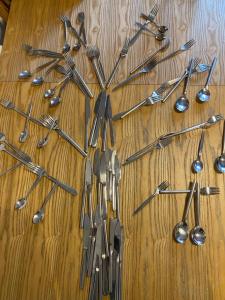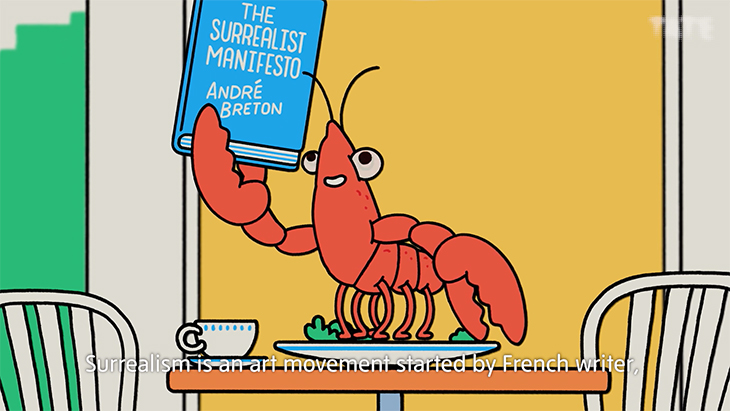Parents know the drill by now. The third UK lockdown has brought with it another opportunity to scrabble around frantically for anything, anything at all, to occupy the little treasures. How many Lego superhero films are too many? Is your seven-year-old really capable of self-directed learning? Will the 11th worksheet be the charm?
Happily, various museums and arts organisations have stepped into the virtual breach, making up for the cultural privations of the pandemic by, hopefully, turning on a new generation to the possibilities of art without making them trail around a gallery.
We started with ‘Art is where the home is’ – activities, workshops, instructional videos and the like from a range of artists in conjunction with Firstsite gallery in Colchester.
That gallery has taken its share of criticism since opening in 2011, first as an expensive ‘white elephant’ with underwhelming visitor numbers, and then due to controversy over payments for HR services to a company linked to one of its (now former) board members. It lost its National Portfolio Organisation status from Arts Council England in 2015 due to concerns over its sustainability, only to regain it in 2018 (and with it a 4-year funding settlement). Given the calibre of its work during the pandemic, that looks an extremely wise decision.
With packs featuring projects developed by artists including Idris Khan, Sarah Lucas, Cornelia Parker, and Grayson Perry, to name a few, the activities are generally engaging, sometimes challenging, and mostly rather good fun. And alongside the bigger names, one activity pack focuses on artists with local connections to the gallery.

Playing the spoons: Bob and Roberta Smith’s ‘Laying the Table for Life’. Courtesy the author
Bob and Roberta Smith’s ‘Lay the Table for Life’ was the biggest hit in our house – telling children to take all the cutlery out of the drawer and lay it out in the shape of a tree on the table was, let’s face it, always likely to be a winner. My daughter set a rule that cutlery could only be replaced in the drawer once it had been removed from the tree and used, which resulted in a happy week eating with branches (forks), leaves (spoons) and trunk (knives).
The breadth and variety of resources available is impressive, capable of filling lockdown three and probably lockdown four too, should it come to that. Though for those parents looking to outsource their childcare (there’s no judgement here), some of the tasks may require a little too much intervention, especially for smaller children. Harold Offeh’s suggestion, of forming a band with the rest of your family then dressing up and posing for a series of timed album cover shots, is a lovely idea; but once you’ve spent half an hour explaining what an album is, and then another faffing about whether Superman or Spiderman or Elsa or Moana would be best on the cover, and then more time again working out how to stand your phone up and set the timer… well, it turns out to be an exhausting endeavour.
For a comprehensive in loco parentis solution, the Tate’s website is hard to beat – introductory videos guide children through major 20th-century artistic movements (a lesson on Surrealism from an animated lobster anyone?), while games invite them to, for example, practice graffiti on a virtual wall. The focus here is more firmly on education, and indeed much of it lines up with primary school art syllabuses. Perhaps most usefully, you could lose a moderately computer-proficient youngster in it for days and feel like they’d emerge with something productive.

Claw learning centre: lessons from a lobster on the Tate website
Major US institutions are, in this as in much else, a little more earnest. The Met offers a fantastic ‘time machine’, which allows kids to filter artworks from its collection by ‘time’, ‘geography’ and ‘big idea’, providing child-friendly explanations for each work and suggesting activities that build on the artwork in question. It’s really great but – perhaps I’m being unkind – feels more like a resource for history of art students on essay deadline than actual children. My seven-year-old lasted about five minutes with it.
It would be churlish to complain about any of this though. These institutions and many others have built quite extraordinary resources for children through the pandemic, in some cases developing what was already there, and in others starting entirely from scratch.
At the beginning of the first UK lockdown, when remote school teaching was rather more haphazard than it is now and a large part of what passes for Covid-19 mitigation seemed to involve encouraging children to stick rainbows emblazoned with ‘NHS’ in their windows, art provided more than solace. For my family, and for others, it became a way of staying rooted in the world; indeed, my children probably spent more time engaging with and creating art during March and April 2020 than they had in the rest of their lives.
The galleries and museums that have encouraged and facilitated this engagement deserve considerable credit, and one can only hope that once their doors reopen and visitors return in numbers, they can keep reaching beyond their physical surrounds and help make it all stick.

In homeschooling hell? Then try packing your kids off to a virtual museum
Young at art: Annie Morris's contribution to FirstSite’s ‘Art is where the home is’ (plus our amateur colouring in)
Share
Parents know the drill by now. The third UK lockdown has brought with it another opportunity to scrabble around frantically for anything, anything at all, to occupy the little treasures. How many Lego superhero films are too many? Is your seven-year-old really capable of self-directed learning? Will the 11th worksheet be the charm?
Happily, various museums and arts organisations have stepped into the virtual breach, making up for the cultural privations of the pandemic by, hopefully, turning on a new generation to the possibilities of art without making them trail around a gallery.
We started with ‘Art is where the home is’ – activities, workshops, instructional videos and the like from a range of artists in conjunction with Firstsite gallery in Colchester.
That gallery has taken its share of criticism since opening in 2011, first as an expensive ‘white elephant’ with underwhelming visitor numbers, and then due to controversy over payments for HR services to a company linked to one of its (now former) board members. It lost its National Portfolio Organisation status from Arts Council England in 2015 due to concerns over its sustainability, only to regain it in 2018 (and with it a 4-year funding settlement). Given the calibre of its work during the pandemic, that looks an extremely wise decision.
With packs featuring projects developed by artists including Idris Khan, Sarah Lucas, Cornelia Parker, and Grayson Perry, to name a few, the activities are generally engaging, sometimes challenging, and mostly rather good fun. And alongside the bigger names, one activity pack focuses on artists with local connections to the gallery.
Playing the spoons: Bob and Roberta Smith’s ‘Laying the Table for Life’. Courtesy the author
Bob and Roberta Smith’s ‘Lay the Table for Life’ was the biggest hit in our house – telling children to take all the cutlery out of the drawer and lay it out in the shape of a tree on the table was, let’s face it, always likely to be a winner. My daughter set a rule that cutlery could only be replaced in the drawer once it had been removed from the tree and used, which resulted in a happy week eating with branches (forks), leaves (spoons) and trunk (knives).
The breadth and variety of resources available is impressive, capable of filling lockdown three and probably lockdown four too, should it come to that. Though for those parents looking to outsource their childcare (there’s no judgement here), some of the tasks may require a little too much intervention, especially for smaller children. Harold Offeh’s suggestion, of forming a band with the rest of your family then dressing up and posing for a series of timed album cover shots, is a lovely idea; but once you’ve spent half an hour explaining what an album is, and then another faffing about whether Superman or Spiderman or Elsa or Moana would be best on the cover, and then more time again working out how to stand your phone up and set the timer… well, it turns out to be an exhausting endeavour.
For a comprehensive in loco parentis solution, the Tate’s website is hard to beat – introductory videos guide children through major 20th-century artistic movements (a lesson on Surrealism from an animated lobster anyone?), while games invite them to, for example, practice graffiti on a virtual wall. The focus here is more firmly on education, and indeed much of it lines up with primary school art syllabuses. Perhaps most usefully, you could lose a moderately computer-proficient youngster in it for days and feel like they’d emerge with something productive.
Claw learning centre: lessons from a lobster on the Tate website
Major US institutions are, in this as in much else, a little more earnest. The Met offers a fantastic ‘time machine’, which allows kids to filter artworks from its collection by ‘time’, ‘geography’ and ‘big idea’, providing child-friendly explanations for each work and suggesting activities that build on the artwork in question. It’s really great but – perhaps I’m being unkind – feels more like a resource for history of art students on essay deadline than actual children. My seven-year-old lasted about five minutes with it.
It would be churlish to complain about any of this though. These institutions and many others have built quite extraordinary resources for children through the pandemic, in some cases developing what was already there, and in others starting entirely from scratch.
At the beginning of the first UK lockdown, when remote school teaching was rather more haphazard than it is now and a large part of what passes for Covid-19 mitigation seemed to involve encouraging children to stick rainbows emblazoned with ‘NHS’ in their windows, art provided more than solace. For my family, and for others, it became a way of staying rooted in the world; indeed, my children probably spent more time engaging with and creating art during March and April 2020 than they had in the rest of their lives.
The galleries and museums that have encouraged and facilitated this engagement deserve considerable credit, and one can only hope that once their doors reopen and visitors return in numbers, they can keep reaching beyond their physical surrounds and help make it all stick.
Unlimited access from just $16 every 3 months
Subscribe to get unlimited and exclusive access to the top art stories, interviews and exhibition reviews.
Share
Recommended for you
School visits to museums are vital – so let’s hope they can restart soon
Though inevitable, the suspension of school visits this year is a great loss – and a reminder of how important children are to the future of museums
The museum pieces that every school kid needs to see
Leading figures pick objects from UK collections that should be seen by every child in the country
The museum pieces that every school kid in the US needs to see
Five leading museum directors pick objects that should be seen by every child in America